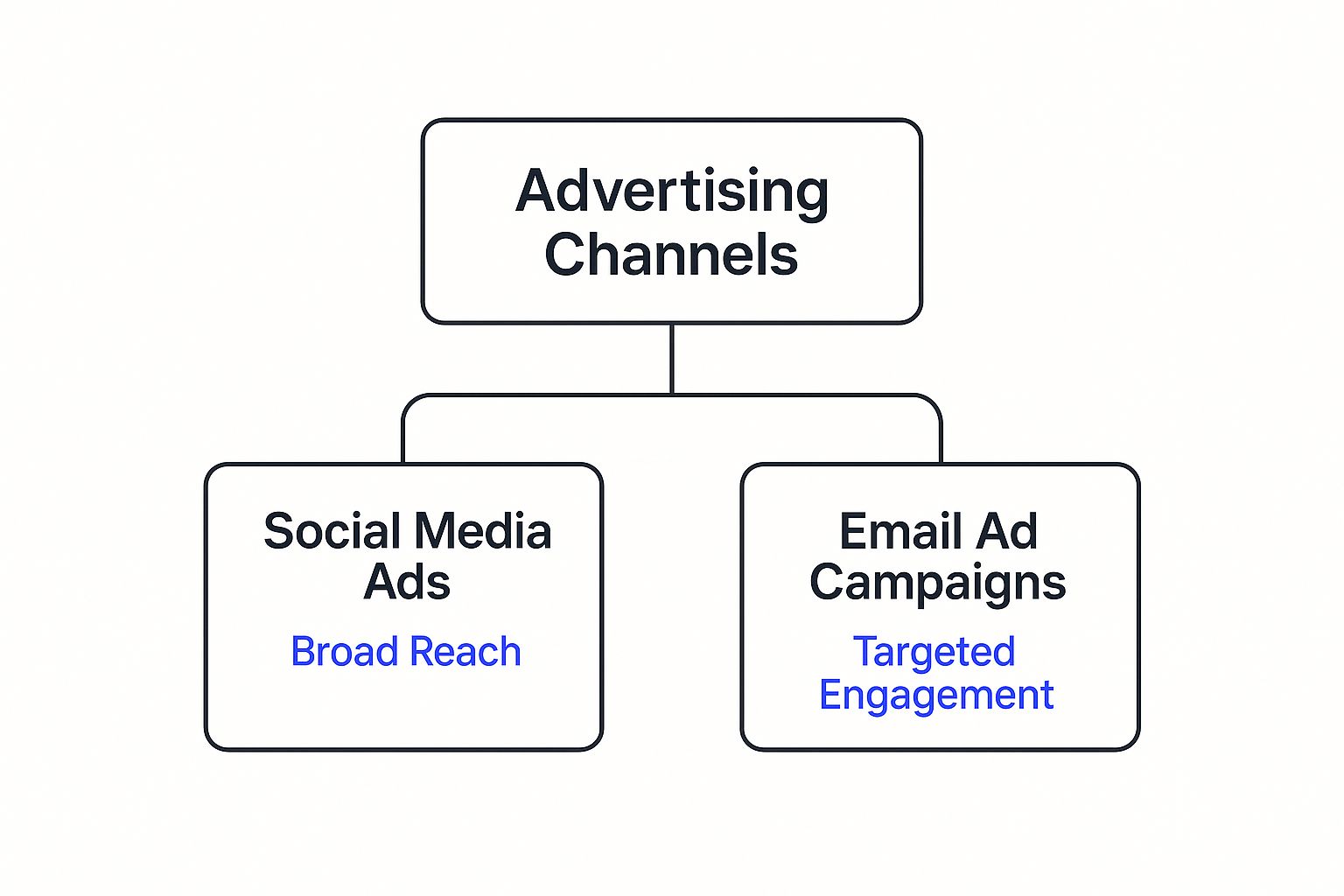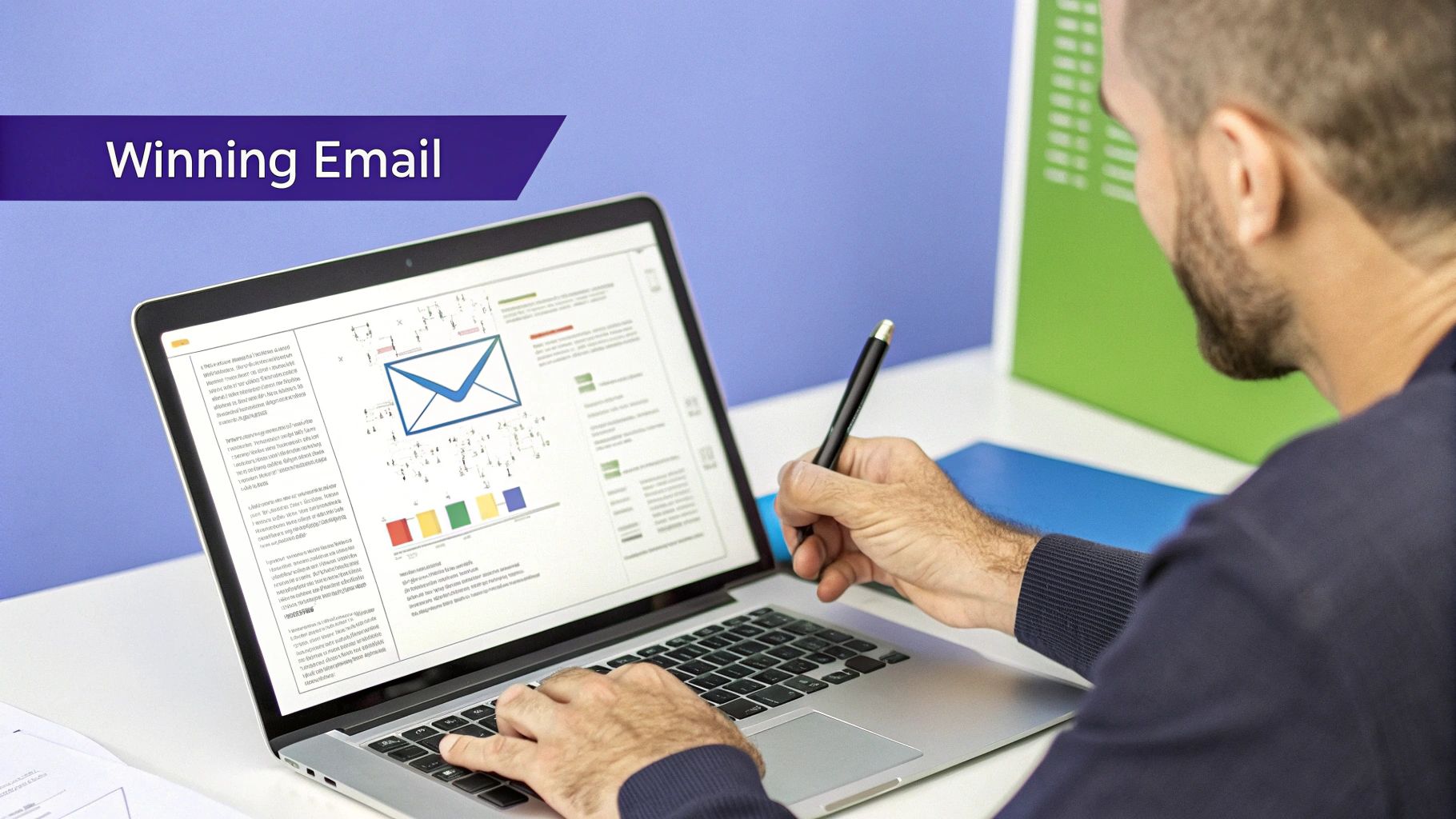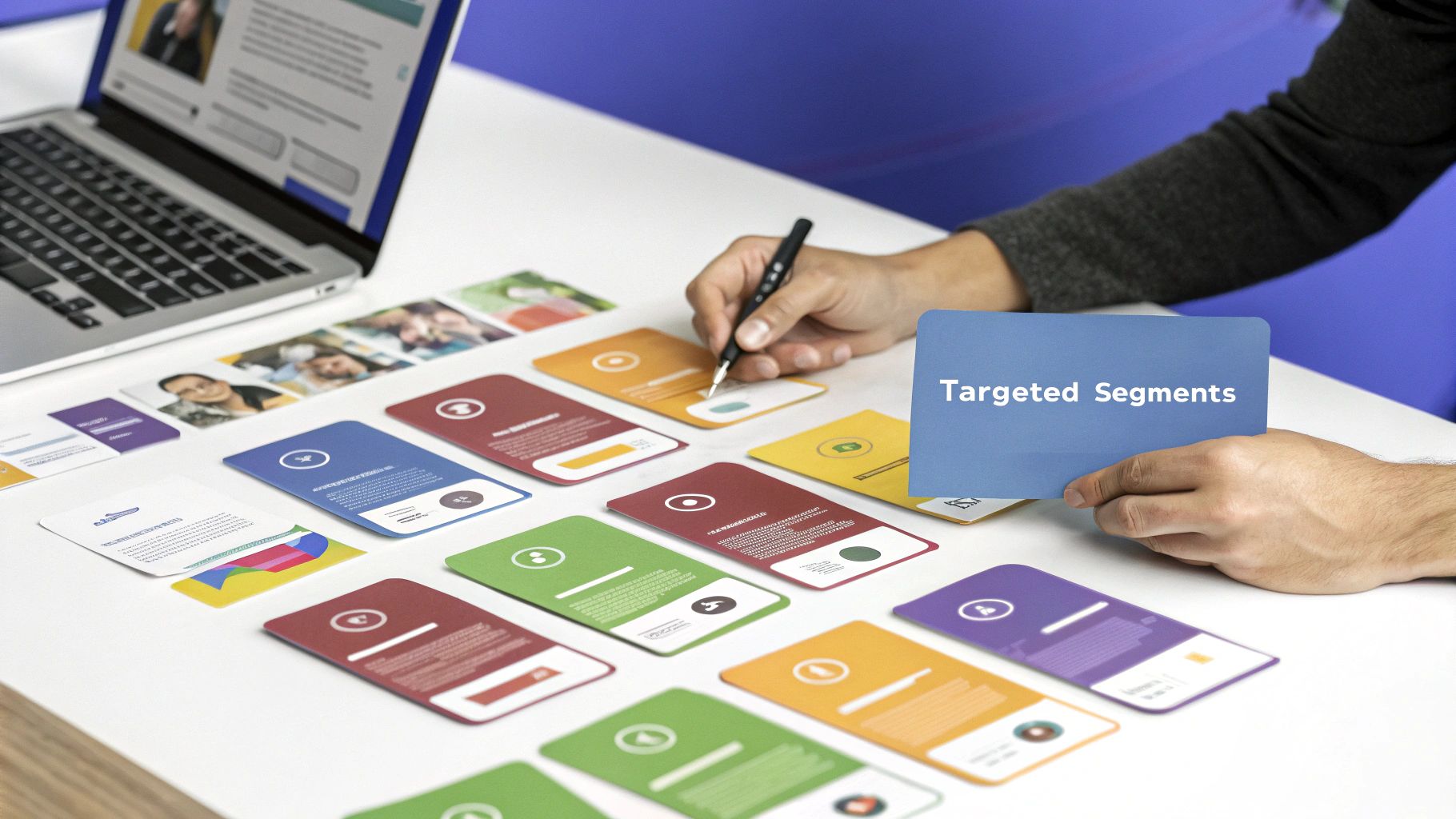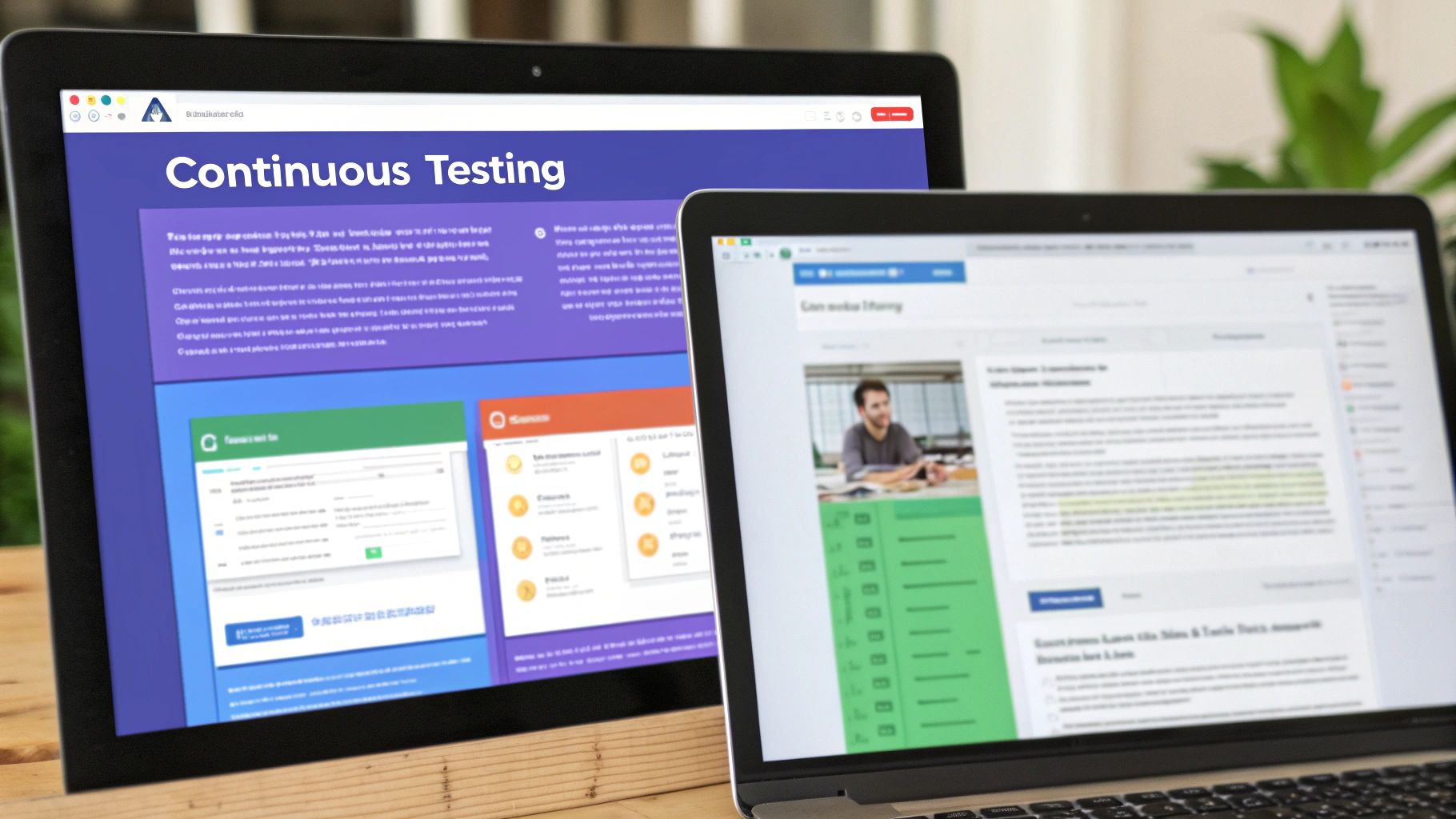Unlock the power of email ad campaigns with this guide. Learn proven strategies to build, measure, and optimize your campaigns for maximum ROI and revenue.
Let's get straight to the point: an email ad campaign isn't just another newsletter blast. It’s a precision-guided advertising channel delivered directly to a hand-picked audience, designed to drive a very specific action—and ultimately, revenue. Think of it less like a mass mailing and more like a personal invitation sent only to prospects who've already raised their hands.
Why Email Ads Are Your Most Direct Revenue Channel
It's time to cut through the noise. While a social media ad is like a highway billboard—seen by thousands but truly relevant to a handful—an email ad campaign is a direct conversation with your most qualified contacts. It’s a dedicated, one-to-one channel for nurturing high-intent leads, launching new products, and closing deals with an audience that has explicitly opted in to hear from you.
This direct line isn't just a marketing tactic; it's a core gear in your Revenue Operations engine. For B2B SaaS and Fintech companies, where sales cycles are long and every touchpoint counts, these campaigns create a clear, measurable link between a marketing action and its revenue impact. As a RevOps leader, your goal is to build a predictable revenue machine. Email ad campaigns are a critical gear in that machine, offering unparalleled targeting, clear attribution, and a direct impact on pipeline velocity.
Moving from Broad to Targeted Advertising
The real difference comes down to intent. Someone scrolling through social media might passively glance at an ad, but an email subscriber has given you explicit permission to enter their inbox. That permission creates a powerful opportunity you can't get anywhere else.
This infographic nails the fundamental shift from casting a wide, expensive net to having a targeted, efficient conversation.

Infographic comparing Social Media Ads for broad reach versus Email Ad Campaigns for targeted engagement.
As you can see, email lets you stop shouting into the void and start focusing your resources on prospects who are genuinely more likely to convert. In specialized markets where finding the right audience is half the battle, this isn't just an advantage—it's everything.
The Power of Email in the AE Market
This isn't just theory; the market data backs it up. In the Middle East and Africa (MEA) region, email marketing isn't just relevant—it's dominant. According to a Grand View Research report, email marketing commands 27.08% of the entire marketing automation market's revenue. That makes it the single largest contributor, a trend supercharged by digital transformation in key sectors like banking and retail.
For any RevOps leader, the goal is to build a predictable revenue machine. Email ad campaigns are a critical gear in that machine, offering unparalleled targeting, clear attribution, and a direct impact on pipeline velocity. - HubSpot, State of Inbound Marketing Trends
Once you grasp the strategic role of email ads, you can start building frameworks that don't just generate leads but actually accelerate your entire sales funnel. The next sections will show you exactly how to do that.
The Anatomy of a Winning Email Ad Campaign
Every great email ad campaign is more than just a well-written message. It’s an engineered system. Think of it like a high-performance engine where every single component has to be perfectly tuned for the whole thing to generate power.
Let's move past the theory and get into the mechanics of what actually works. A winning campaign isn't just one great email; it's a complete process designed to guide a specific person toward a specific action. To get this right every time, you need to master five core elements.
Building Your High-Intent List
Let's be blunt: the quality of your audience is the single most important factor determining your success. A massive list of people who don't care about you is just noise. A smaller, highly engaged list is where the revenue is. Your goal isn't just to hoard email addresses; it's to build a curated audience that has explicitly given you permission to contact them.
Focus your energy on these consent-based methods:
- •Gated Content: Offer genuinely valuable resources like downloadable frameworks, checklists, or industry reports. If it solves a real problem, they'll happily give you their email for it.
- •Webinar Registrations: Anyone signing up for a training session is actively looking for answers. These are warm leads who see you as an expert.
- •Demo Requests: This is your highest-intent group. These are people actively evaluating solutions and who have raised their hand to learn more about your product specifically.
This approach guarantees your email ad campaigns land in the inboxes of people who are already primed to listen, which radically boosts your odds of engagement.
Crafting Subject Lines That Demand to Be Opened
Your subject line is the gatekeeper. It doesn't matter how incredible your offer is if the email never gets opened. And according to research from OptinMonster, a staggering 47% of email recipients open emails based only on the subject line. This is your first, and often only, chance to earn a click.
To cut through the inbox noise, you need subject lines that do the heavy lifting:
- •Be Specific and Value-Driven: Instead of "New RevOps Guide," try "Fix Your Funnel in 6 Weeks With This Blueprint." One is a statement; the other is a promise.
- •Create Urgency or Curiosity: Think "Your RevOps Audit Template Expires Tonight" or "The One Metric Your CEO is Missing." Give them a reason to open it now.
- •Personalize When Possible: Using a recipient's name or company name instantly signals that this isn't just another mass blast.
This first micro-conversion—the open—sets the stage for everything else.
Designing for Impact and Mobile-First Engagement
With over half of all emails now opened on a mobile device, "mobile-first" isn't just a good idea—it's the only way to operate. Your design needs to be clean, scannable, and optimized for a thumb, not a mouse. That means short paragraphs, clear headings, and one—and only one—obvious call-to-action.
Modern email marketing platforms like HubSpot are built for this reality, helping you create campaigns with clean, effective design.

Screenshot from https://www.hubspot.com/email-marketing
As you can see, the focus is on drag-and-drop editors and visual templates. This lets you build professional, mobile-responsive emails without ever touching a line of code.
Writing Copy That Converts
Once they've opened the email, your copy has a single job: guide the reader from their current pain to your proposed solution. The classic AIDA framework (Attention, Interest, Desire, Action) is still one of the best roadmaps for this.
- •Attention: Hook them immediately with an opening line that hits on a known pain point. "Tired of marketing leads that go nowhere?"
- •Interest: Show them you understand their world. Use relatable examples or data to build on that initial pain. "Last quarter, 70% of B2B marketers said lead quality was their top challenge."
- •Desire: Paint a vivid picture of the "after" state. What does life look like once they use your solution? "Imagine your sales team only talking to perfectly qualified, high-intent prospects."
- •Action: Tell them exactly what to do next. Be direct. "Book a 15-minute call to see how we do it."
This isn't about writing clever prose; it's about clarity. Use your customer's own language and keep the focus squarely on the value they stand to gain.
Engineering the Perfect Call-to-Action
Finally, we arrive at the moment of truth: the Call-to-Action (CTA). A vague, passive, or low-value CTA will absolutely crater your conversion rate. The best CTAs are specific, urgent, and packed with value.
A great CTA doesn't just ask for a click; it promises a tangible outcome. It bridges the gap between the reader's interest and the solution you're offering.
Let's look at the difference between a weak CTA and a strong one:
| Weak CTA | Strong CTA | Why It Works |
|---|---|---|
| Learn More | Get Your Free RevOps Audit Template | Promises a specific, valuable tool. |
| Contact Us | Book a 15-Min Pipeline Strategy Call | Sets clear expectations and frames it as a value exchange. |
| Submit | Download the ARR Growth Blueprint Now | Uses action-oriented language and creates urgency. |
By mastering these five components, you stop sending random marketing emails and start building a predictable system for generating engagement and driving revenue.
Using Segmentation to Drive Revenue Growth
Sending the same email to your entire list is like shouting into a crowded room hoping the right person hears you. It’s just noise. This is where we stop broadcasting and start building profitable relationships at scale. Think of effective segmentation as the engine that powers your email ad campaigns, turning generic messages into personal, relevant conversations that actually get opened.
Forget just dropping a {{first_name}} tag in the subject line. Real segmentation goes much, much deeper. It’s about understanding who you’re talking to, what they truly care about, and where they are in their journey with you. Get this right, and the results aren't just noticeable—they're immediate and measurable.

A diagram showing different audience segments being targeted by a focused email campaign.
Actionable Strategies for Audience Segmentation
To build an email strategy that performs, you have to slice your audience based on meaningful data. This lets you tailor your message, your offers, and your timing to hit home with specific groups. For B2B SaaS, it boils down to three critical types of segmentation.
- •
Demographic Segmentation (The "Who") This is your foundation. It’s about grouping your audience by objective, observable facts. It's basic, but absolutely fundamental for making sure your message has the right context.
- •Job Title: A Head of RevOps and a Sales Manager have completely different priorities. Your message needs to reflect that reality.
- •Company Size/ARR: A startup wrestling with its first €4M in revenue has different growing pains than a €50M scale-up.
- •Industry: A Fintech company is worried about compliance; a Martech firm is focused on attribution. The context is everything.
- •
Psychographic Segmentation (The "Why") This is where things get interesting. This layer adds the crucial "why" by focusing on what drives your audience. It helps you understand their goals, motivations, and the problems that keep them up at night.
- •Goals: Are they trying to slash their sales cycle from 90 to 60 days, clean up their Salesforce data, or prove marketing ROI to the board?
- •Challenges: Are they struggling with a messy tech stack, a leaky pipeline where 40% of leads drop off, or total misalignment between sales and marketing?
- •
Behavioural Segmentation (The "What") This is, without a doubt, the most powerful form of segmentation. Why? Because it’s based on what people do, not what you assume they'll do. It's a direct signal of their intent and interest level.
- •Website Activity: Did they just spend five minutes on your pricing page? Or download a specific case study?
- •Content Engagement: Have they attended every webinar you've hosted on sales forecasting? Or read every blog post on CRM data?
- •Past Purchases: Are they an existing customer of one product who is a perfect fit to be cross-sold on another?
"The goal isn't just to collect data; it's to use that data to send the right message to the right person at the right time. A well-segmented email feels less like an ad and more like a helpful piece of advice." - David Cancel, CEO of Drift
Putting Segmentation into Practice
Let’s walk through a real-world scenario. Your analytics flag a group of users who checked out your pricing page and a specific case study in the last seven days, but never booked a demo. This is a red-hot, high-intent segment practically waving a flag.
Instead of hitting them with a generic newsletter, you deploy a targeted, two-part email sequence:
- •Email 1 (Day 1): A simple, plain-text email from a sales leader. It references the case study they viewed and offers a quick, 15-minute chat to discuss how those results could apply to their business. No fluff.
- •Email 2 (Day 3): A follow-up with a direct link to a downloadable ROI calculator, making it easy for them to build a business case for their boss.
This is the surgical precision that turns passive lurkers into active buyers. For instance, a B2B SaaS company we worked with implemented a similar behavioral trigger campaign and saw a 52% uplift in trial-to-paid conversion from that specific segment alone within 8 weeks.
Of course, this kind of power hinges on one thing: clean, organized data in your CRM. If your data is a disaster, your segments are useless. Running a regular CRM audit and focusing on data hygiene isn't just a chore; it's the foundational work that makes these advanced strategies possible. Without it, even the most brilliant campaign idea is dead on arrival.
Measuring What Matters for Email Campaign Success
Let's be honest. Vanity metrics like open rates are interesting, but they don't pay the bills. For a RevOps pro, the only numbers that truly matter are the ones that tie directly back to revenue.
Success isn't about how many people opened your email. It's about how many of those opens turned into pipeline, closed deals, and real business growth. We need to shift from a marketing-centric view to a revenue-focused one.
Your data has to answer three critical questions:
- •Are we even reaching the right people?
- •Is our message compelling enough to make them act?
- •Is this whole effort actually making us money?
Foundational Delivery Metrics
Before you can even think about engagement, you have to know if your emails are actually showing up. Without solid deliverability, even the most brilliant email ad campaigns are dead on arrival.
- •Deliverability Rate: This is the percentage of your emails that successfully landed in an inbox without bouncing. A healthy rate—ideally 98% or higher—tells you you're working with a clean, high-quality list.
- •Bounce Rate: This tracks the emails that couldn't be delivered. If your bounce rate creeps above 2%, it's a major red flag. It signals serious list quality problems that can absolutely wreck your sender reputation.
Think of these two metrics as the foundation of your house. If the foundation is cracked, everything you build on top is at risk of collapsing.
Engagement and Conversion Metrics
Okay, so your emails are landing. Now, is anyone listening? This is where you measure how well your copy, your offer, and your call-to-action are working together to persuade your audience to take that next step.
Your click-through rate is the first true indicator of intent. It separates passive readers from active prospects and signals that your message has struck a chord.
This is the moment you start tracking the journey from simple interest to decisive action.
- •Click-Through Rate (CTR): What percentage of people who got your email clicked on at least one link? For B2B, a CTR of 2-5% is a decent benchmark, but this can vary wildly depending on your industry and how engaged your audience is.
- •Conversion Rate: This is the ultimate test of your email's power. It tracks the percentage of recipients who actually did the thing you wanted them to do—book a demo, download a guide, or make a purchase.
Improving your conversion rate is about more than just tweaking a button color; it requires a deep understanding of what truly motivates your audience. To get that clarity, you need the right attribution model in place. Our detailed attribution model case study shows exactly how connecting marketing actions to sales outcomes can give you the insights needed to make much smarter decisions.
Revenue-Focused Business Metrics
Now for the question your C-suite really cares about: is this generating real value? This is where RevOps shines by connecting the dots between a marketing campaign and the company's bottom line. These are the numbers that justify your budget and prove your impact.
- •Return on Investment (ROI): The ultimate bottom-line metric. It’s the total revenue generated from the campaign divided by what you spent to run it. Simple, but powerful.
- •Customer Acquisition Cost (CAC): How much, on average, did it cost to land a new customer through this specific campaign?
- •Customer Lifetime Value (LTV): How much revenue can you expect from a customer acquired through this channel over their entire relationship with you? A healthy LTV-to-CAC ratio (aim for 3:1 or higher) is proof that your campaigns are bringing in profitable customers, not just vanity logos.
And the data backs this up. Email marketing continues to deliver incredibly strong returns. In Eastern markets like the UAE, for example, email marketing sees an average ROI of around 37%. It consistently outperforms other channels, partly because 68% of local businesses are prioritizing digital marketing spend.
A Framework for Continuous Campaign Optimization
Great campaigns aren’t born; they're built. The difference between an email that gets ignored and one that drives revenue often comes down to a series of small, strategic tweaks. Moving away from guesswork and towards a culture of relentless, data-driven iteration is how you turn a decent email ad campaign into a predictable growth engine.
This isn't about random changes. It's about a simple, repeatable framework for testing. By systematically questioning your assumptions and letting your audience's behavior guide you, you build an internal library of what actually works for your specific market. It’s a process of turning small, incremental wins into significant, compounding gains over time.

A split-screen image showing two versions of an email for A/B testing, with analytics icons indicating data analysis.
The Four-Step Testing Cycle
To get results you can trust, you need a structured process. This four-step cycle ensures every test you run provides a clear, actionable insight that makes your next campaign smarter than the last.
- •
Form a Clear Hypothesis: Every test has to start with a specific, measurable question. A weak hypothesis is, "Let's test a new subject line." A strong one sounds like this: "Using a question-based subject line that highlights a common pain point will increase our open rate by 15% compared to our standard statement-based subject line." See the difference?
- •
Isolate a Single Variable: This is the golden rule of A/B testing. If you change the subject line, the CTA button color, and the main image all at once, you'll have no idea which change drove the result. Test one thing at a time. It’s the only way to get a clean, unambiguous answer.
- •
Run a Statistically Significant Test: Don't just send 50 emails for each version and call it a day. To actually trust your results, you need a large enough sample size to ensure the outcome wasn't just random chance. Most modern email platforms have built-in calculators to help you figure this out. Use them.
- •
Analyze and Scale the Winner: Once the test is done, dig into the data. Was your hypothesis right? Whichever version performed better against your key metric—opens, clicks, conversions—becomes the new control. You then roll out this winning variation to the rest of your audience and start the cycle all over again with a new hypothesis.
"A/B testing is the disciplined practice of turning your best guesses into hard data. It replaces 'I think this will work' with 'I know this works better,' which is the foundation of any scalable RevOps strategy." - Brian Balfour, former VP of Growth at HubSpot
High-Impact Elements to Test
Not all tests are created equal. To get the biggest bang for your buck, focus on the elements that have the most direct impact on whether a user takes action. Start here.
- •Subject Lines: This is your first impression. Test different angles—questions vs. statements, urgency vs. curiosity, or personalization vs. broad value props.
- •Call-to-Action (CTA) Copy: Experiment with action-oriented verbs. A simple switch from "Book Your Demo" to "See a 15-Min Live Preview" can have a massive impact.
- •CTA Format: Test a simple text link against a visually prominent button. Button color and placement can also have a surprising effect on click-through rates.
- •Email Body Copy: Try different opening hooks. Test long-form, detailed copy against something short, punchy, and scannable.
- •Visuals: Does an authentic customer photo outperform a polished product screenshot? Does adding a GIF actually increase clicks? Test it.
By methodically working through this framework, you move beyond one-off campaign wins. You start building a systematic understanding of your audience's psychology, allowing you to engineer more effective email ad campaigns with increasing predictability and impact.
Integrating Email into Your RevOps Engine
An email ad campaign should never operate in a silo. When you treat it as just another marketing tactic, you’re leaving a ton of value on the table. To really unlock its power, you have to weave it directly into the fabric of your Revenue Operations engine. This transforms it from a standalone activity into a critical source of intelligence for your entire go-to-market team.
What this really means is creating a seamless, automated data flow between your email platform, your CRM, and your sales engagement tools. It’s about building a system where marketing actions instantly translate into sales opportunities and valuable customer insights.
Creating a Unified Customer Journey
Imagine this common scenario: a high-value prospect clicks a link to a specific case study in one of your emails. In a disconnected system, that’s just a click. Big deal.
But in a fully integrated RevOps engine, that single engagement signal can automatically trigger a whole sequence of value-add actions. It’s the difference between being reactive and being proactive.
The real goal of integration is to make your GTM engine smarter. Every email click, open, and reply becomes a data point that enriches your understanding of a prospect's intent, allowing sales to engage with perfect timing and context.
This level of integration doesn’t happen by accident; it requires a clear strategy. You need to map out the entire data and workflow process. A proper RevOps framework can help you diagnose these disconnects and get your tech stack aligned for maximum impact.
Accelerating the Entire Revenue Funnel
When your systems are actually talking to each other, email campaigns become a powerful accelerator for the entire sales funnel. An integrated approach provides invaluable feedback that benefits teams far beyond marketing.
Here’s how it works in practice:
- •For Sales Teams: Engagement data helps prioritize follow-ups. A prospect who clicks on pricing-related content gets immediately flagged as a higher-priority lead. This shortens the time to engagement from days to hours and can increase conversion rates by over 30%.
- •For Product Teams: Which features or benefits are getting the most clicks in your emails? This data is direct, real-world feedback on what messages are resonating with the market, which can and should inform future product development.
- •For Success Teams: Tracking how existing customers engage with emails about new features or best-practice guides helps identify opportunities for upselling. It also signals which accounts are most engaged with your brand, and which might be at risk.
This integrated mindset is especially crucial in growing markets. Take the Gulf Cooperation Council (GCC) countries, for example. As highlighted in these insights from Grand View Research, email advertising spend there is poised for substantial growth, forecasted to hit approximately USD 100.83 million in 2025 due to rapid digitalization.
By connecting email to your core revenue engine, you build a system that not only captures this growth but converts it into predictable revenue.
Your Top Questions, Answered
Even the most buttoned-up RevOps pros hit a wall now and then when fine-tuning their email campaigns. Let's tackle some of the most common questions that come up in the trenches.
How Often Should I Actually Send These Emails?
There’s no silver bullet, but the goal is to be consistently visible without becoming inbox noise. For most B2B SaaS audiences, a great starting point is one high-value email per week for each specific segment you're targeting.
The real answer, though, comes from your data. The key is to obsessively monitor your unsubscribe and engagement rates. If you test a second weekly email and see unsubscribes spike by 25% or more, you've got your answer—pull it back. Your audience will tell you what they can tolerate.
What's the Real Difference Between a Newsletter and an Ad Campaign?
Think of it like this: a newsletter is your relationship-builder. It’s like a regular coffee meeting, designed for broad company updates, sharing content, and nurturing your audience over the long term. It might have several different calls to action.
An email ad campaign, on the other hand, is a revenue-driving tool. It’s a surgical strike with a single, highly specific goal, like driving demo bookings for a new feature or pushing a limited-time offer. It's built around one CTA, and its success is measured in direct revenue impact.
What are the Best Tools for Managing Campaigns?
Trying to manage campaigns from a basic email client is a recipe for disaster as you scale. You need a dedicated platform that talks directly to your CRM.
- •For Startups: Tools like Mailchimp or Brevo are fantastic entry points. They get the job done without overwhelming you.
- •For Scaling Companies: This is where platforms like HubSpot shine. They offer a more integrated suite, connecting your email marketing directly to your CRM and sales plays.
- •For Enterprise: Heavy hitters like Marketo and Salesforce Marketing Cloud provide the robust automation and deep analytics needed for complex, multi-channel campaigns.
How Do I Keep My Emails Out of the Spam Folder?
Deliverability is everything. If you’re consistently landing in spam, you’re burning money and killing your ROI.
To stay in the primary inbox, always get explicit consent (opt-in is non-negotiable). Keep your lists clean by regularly purging inactive subscribers. Most importantly, make sure your emails are authenticated with protocols like SPF and DKIM. These are the technical handshakes that prove to email providers that you are who you say you are.
Ready to stop guessing and start building a predictable revenue engine? The team at Altior & Co. specializes in fixing broken go-to-market motions for B2B SaaS companies. We deliver a RevOps Growth Blueprint in as little as six weeks to align your teams and expose the pipeline gaps that are holding back your growth. Book your Revenue Funnel Review today.


